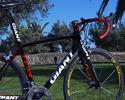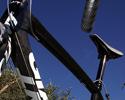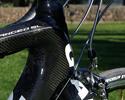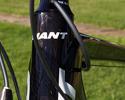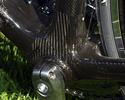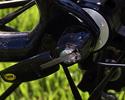
Recently on Cyclingnews.com |
Tech feature: Giant 2009 road introduction, June 22, 2008
Giant unveils seven new road models for 2009
Giant’s road lineup has been heavily revamped for 2009 with new construction techniques, technologies and shapes. Cyclingnews technical editor James Huang heads to the Mediterranean to sample some of Giant’s best for the coming season.
Killer new race machine for Team Columbia
Last year’s TCR Advanced ISP was a pure race bike through-and-through with excellent overall rigidity and handling manners but it wasn’t the most comfortable or lightest chassis around and you really had to ride it hard to get the most out of it. For 2009, Giant sought to improve on the current version’s strengths but also provide more of a balance by improving on its weaknesses. Based on our initial taste test, it seems the new 2009 TCR Advanced SL achieved that goal rather handily.
Giant claims the new chassis is now just 1497g (painted medium frame with uncut mast, uncut fork, integrated seatmast head and all applicable hardware), making it over 200g lighter than last year’s version yet also a whopping 42 percent stiffer overall (including a 26 percent jump specifically in pedaling efficiency). Moreover, these improvements come with a more comfortable ride to boot. Those numbers are decidedly tough to swallow at first but the rigidity claims are believable even by just visual inspection: compared to the new model’s imposing size increases, the old model (which was no slouch in the beef department) now looks decidedly underfed.
The TCR Advanced SL’s down tube wears a gargantuan rectangular profile roughly 80mm across at its base and the top tube sports a bigger trapezoidal shape as opposed to last year’s roundish pipes. Both of those tubes also partially wrap themselves around a newly tapered-and-oversized 1 1/8"-to-1 1/4" front end for additional bracing. The matching fork is bigger and wider than before, too, and the lower bearing set is integrated into the crown to eliminate sharp fiber bends and also to drop a few grams. Out back, asymmetrical chain stays have also grown in size and now mate to an 86mm-wide shell with press-fit bearing cups while the seat stays actually look to have gotten a touch smaller.
The top tube, head tube and down tube are molded as a single unit, as are the seat tube, chain stay and seat stay assemblies but how those bits are joined is new for ‘09. Standard bonding methods are used at the bottom bracket and dropouts but the chain stay yoke and top tube are joined to the seat tube using a new ‘Fusion’ procedure.
According to Giant, Fusion is similar in concept to wrapped tube-to-tube joints but goes one step further by placing the entire frame back in a mold and re-baking it under high pressure. Giant says the process yields fewer voids and more strength than just re-baking alone and shaves 100g from the TCR Advanced SL over more conventional bonding.
As was the case with last year’s bike, Giant still builds the TCR Advanced SL in its own Taiwanese factory from start-to-finish. Even the raw Toray carbon fibers are woven in-house and the company fabricates its own pre-preg sheets with its own custom resins for better quality control.
We can’t quantifiably verify Giant’s "42 percent stiffer" claim but no one will be able to dispute the new model’s substantially more solid feel after even a short test ride. Drivetrain response seems markedly snappier and there’s absolutely no second-guessing the extra rigidity up front: there’s less twist when hammering out of the saddle and heavy braking at high speed is especially reassuring.
In fact, the new model closely mimics the feel of the specially reinforced T-Mobile team bike we tested last year, only in this case there are no extra carbon plies to weigh it down and the ride quality is far more refined than even a stock ’08 TCR Advanced. The new model is certainly no cushy Sunday cruiser but high-frequency chatter is impressively well-damped without killing the frame’s road feel and the bike no longer crashes violently over bigger impacts like it used to. For sizing ease, our test bike was equipped with Giant’s conventionally telescoping Vector aero seatpost but production ISP versions should ride even better as there’s noticeably more flex at its newly small-diameter base.
In short, the new TCR Advanced SL still begs to be thrashed like the old one, but now you don’t necessarily have to ride it like that to appreciate its potential. We wouldn’t hesitate to race it on the weekend but we might also be just as happy just heading out for an all-day training ride. As long as your local roads are in decent shape, even recreational riders should find the ride quality surprisingly acceptable as long as the quick reflexes suit you.
TCR Advanced ‘lite’
Those riders looking for most of the TCR Advanced SL performance but a more modest sum can instead opt for the similarly all-new standard TCR Advanced. Slightly lesser fibers and a more conventional Fusion-less construction method produce a frame that’s only 140g heavier, 5 percent less rigid up front and only 9 percent softer in drivetrain stiffness, according to Giant. More to the point, it’s still 235g lighter than last year’s TCR Composite and heaps stiffer overall.
The 1 1/8"-to-1 1/4" front end and press-fit 86mm-wide bottom bracket shell are used here as well but tube shapes are slightly modified (most noticeably around the head tube and seat cluster) and the deep-section Vector seatpost will probably ride a tad rougher than the TCR Advanced SL’s ISP. Even so, this model strikes us as far-and-away the better value for those who don’t quite need (or can afford) Giant’s absolute top of the line.
Defy conventional habits
In addition to the new TCR models, Giant will also debut a new line of ‘performance’ bikes for 2009 called Defy. As compared to the OCR lines it replaces, Defy promises a heavier dose of TCR DNA while still offering the slightly more upright position, relaxed handling and softer ride that more and more riders seek nowadays. Three levels will be offered: the full-carbon Defy Advanced, the aluminum-and-carbon Defy Alliance and the standard Defy made from Giant’s ALUXX aluminum tubing.
Giant definitely achieves the visual part of that goal as the Defy trades in the OCR’s somewhat bland styling for a more aggressive skin that gives some clues as to the new features hidden beneath. As on the TCR, all of the Defy frames incorporate the tapered-and-oversized 1 1/8"-to-1 1/4" front end and stouter tubing throughout; all but the standard aluminum Defy will also feature the wider press-fit bottom bracket design.
In fact, Giant says the top-end Defy Advanced’s front triangle is just as rigid as last year’s TCR Advanced and the rear end is 13 percent stiffer, making for a machine that should be just as efficient as standard High Road team bikes from last year but far more comfortable.
We’re not entirely sure we can back up that claim after riding the Defy Advanced ourselves but, to be fair, it probably wasn’t entirely fair that that trial immediately followed that of the über-rigid TCR Advanced SL. Either way, the Defy Advanced is remarkably comfortably and swallowed any pavement imperfections we could find, big or small (although given the superb condition of Mallorcan roads, there weren’t many). The superb comfort seems to come at the expense of snappiness, though; as compared to the TCR, the Defy Advanced felt slightly ‘delayed’ both in terms of handling and drivetrain response but most riders probably won’t care much. All in all, the Defy could very well be an ideal setup for most consumers that are just heading out for fast, long rides and don’t necessarily need the right-now quick reflexes of a full-blown race rig.
Giant for Women holds (almost) nothing back
Giant will wisely offer all-new women’s versions of each of the new platforms, too, save for the top-end TCR Advanced SL. Each of the TCR Advanced W, Avail (analogous to the Defy) and Aeryn (sister line to the Trinity time trial/triathlon range) models will share identical features and technologies but with adjusted geometries, components specifications and sizing as necessary. As such, women should find the exact same performance characteristics as on the men’s versions but with a better fit.
The second coming of the compact frame revolution?
Giant turned the road bike world on its ear when it first introduced its compact frame geometry ten years ago and with such a comprehensive revision to its road bike range, the company is hoping for a similar impact this time around. We don’t know about a ‘revolution’, but based on what we’ve sampled so far the next few years at least looking very good.
Photography
For a thumbnail gallery of these images, click here
Images by James Huang/Cyclingnews.com
- Giant's new TCR Advanced SL is noticeably stiffer and more comfortable than the previous version. It looks better, too, especially in top-flight trim as seen here with SRAM Red and Mavic Cosmic Carbone Ultimate wheels.
- The Dura-Ace version is only slightly more sedate with a purposely black-and-white paint job.
- The new TCR Advanced SL's defining feature is arguably the tremendously reinforced head tube which houses a tapered and oversized 1 1/8"-to-1 1/4" steerer tube.
- The top tube and down tube of the TCR Advanced SL is actually a bit wider than the head tube. Fore-aft stiffness under braking and steering precision were superb.
- How much stiffness do you want? The TCR Advanced SL's top tube flares noticeably up front.
- The matching fork's stout legs and 1 1/4" steerer tube base make for a noticeably reassuring feel when the stoppers are clamped hard.
- The huge down tube uses a rounded rectangular profile that contributes to the claimed 42 percent increase in overall rigidity over the previous TCR Advanced.
- Naturally, the giant down tube also provides plenty of room for a correspondingly huge logo.
- Giant's use of the new press-fit bottom bracket format allows the down tube to reach roughly 80mm across in width.
- The seat tube certainly isn't much narrower at the bottom bracket, either, and the asymmetric chain stays are wide-set, too.
- The trick rear brake cable routing apparently isn't just for show; it virtually guarantees that you'll never rub your leg on the housing and the centered position underneath the down tube easily accommodates reverse-style lever setups.
- In spite of current trends, Giant is sticking with one-piece aluminum dropouts and fork tips instead of carbon fiber.
- Giant was ridiculed ten years for its then-radical compact frame geometries but few are still laughing now.
- Production TCR Advanced SL bikes will all be equipped with integrated seatmasts. Bare frames will be offered with standard posts but the integrated design actually flexes more fore-aft for increased comfort.
- The newly refined seatmast head is far cleaner looking and offers 10mm or 23mm of setup simply by flipping the clamp hardware 180 degrees.
- Giant's 'Fusion' process is used at the seat cluster on the new TCR Advanced SL. The joint is wrapped but then re-baked in a mold for better compaction and joint strength.
- Relatively slim seat stays contribute to the (reasonably) comfy rear end. Standard seatpost versions sport a deeper seat tube profile than the roughly round shape of the ISP frame.
- The standard TCR Advanced is all-new as well and while it uses slightly lesser materials, the overall feel is very similar to the full-blown TCR Advanced SL.
- The TCR Advanced's head tube is also noticeably oversized and houses a 1 1/8"-to-1 1/4" steerer tube.
- There's a lot of beef up here and the solid front end promises sharp handling and braking.
- Standard TCR Advanced frames are equipped with conventional aero-profiled seatposts and a slightly cutout in the seat tube.
- The top tube of the TCR Advanced is vaguely trapezoidal in profile.
- There isn't quite as much flaring up here as on the TCR Advanced SL but the proportions are still awfully big.
- A more conventional bonded modular monocoque construction is used for the standard TCR Advanced.
- The two-bolt seatpost head holds tight and cleverly integrates both 10mm and 23mm offsets without having to swap parts.
- The Defy Advanced is Giant's new 'performance' bike for 2009 with a slightly more relaxed geometry than the TCR series.
- A taller head tube and longer chain stays make for a more upright fit and more stable handling.
- Giant is using tapered and oversized 1 1/8"-to-1 1/4" steerers on the majority of its road lineup, including on the new Defy Advanced.
- The front end of the Defy Advanced isn't quite as humungous as the TCR bikes and provides a noticeably softer ride.
- Although pegged as a 'performance' rig and not a full-blown race machine, there's still plenty of beef to be found around the Defy Advanced bottom bracket shell.
- Yup, press-fit cups can be found here, too.
- The aero seatpost profile carries through to the top portion of the seat tube.
- Sorry, you won't be fitting your Thomson seatpost in here but Giant has thankfully gone to the trouble of including a rather nice bit here for you already.
- The Avail Advanced is the women's-specific version of the Defy Advanced.
- All of the Defy Advanced's major tech features are included here but the geometry has been adjusted for women's typically-shorter torsos.
- Giant has wholeheartedly adopted the press-fit bottom bracket standard.
- Need to go faster? Women have their own version of the TT/tri-specific Trinity called the Aeryn.
- Bladed fork blades help slice through the air.
- The Aeryn Alliance uses an aluminum lower half paired with a carbon fiber top half for reduced cost, better stiffness and good ride quality.

